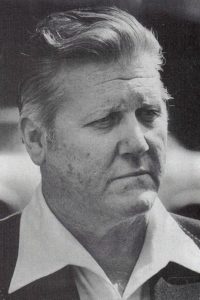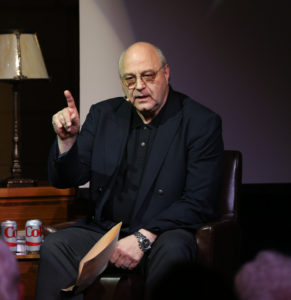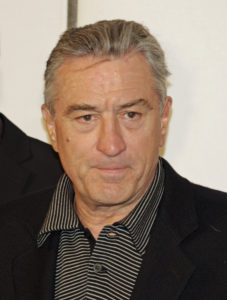
New Scorsese movie to spotlight Jimmy Hoffa’s disappearance
Film will focus on Frank ‘The Irishman’ Sheeran’s version of labor leader’s 1975 murder

Every summer, speculation heats up regarding one of the nation’s great Mob mysteries: What happened to Jimmy Hoffa?
After serving time in prison for jury tampering and pension fraud, Hoffa, a Mob-connected former president of the International Brotherhood of Teamsters, was attempting to regain control of the nationwide labor union from his base in Detroit when he went missing on July 30, 1975. He was 62 years old.
According to published accounts, his disappearance possibly was the result of disagreements with ranking Mob members. The theory is that some Mafia leaders were upset at Hoffa, a vindictive score-settler with a big ego, for threatening to expose the union’s links to organized crime and end the Mob’s use of its pension funds.

Hoffa was supposed to have met that July afternoon with Mafia heavyweights at the Machus Red Fox, a suburban Detroit restaurant, to resolve differences, but he vanished from the parking lot. Despite numerous tips, authorities have never recovered his body, and no one has been charged with any crime in the matter. The most famous urban legend has it that he was buried in the now-demolished Giants Stadium in New Jersey. Though that theory has been discounted, uncertainty remains over his final whereabouts.
“The disappearance of Jimmy Hoffa is still a mystery,” Mob historian Jerry Capeci has written, “although there’s no doubt he was murdered.”
The mystery has taken on an added twist this time around with the anticipated release on Netflix next year of The Irishman, a film by director Martin Scorsese. The movie is expected to assert that hit man Frank Sheeran murdered Hoffa on orders from the Mob. Sheeran, a tough, 6-feet, 4-inch former World War II combat soldier and Delaware Teamsters leader, was nicknamed “The Irishman.”
The Scorsese movie, featuring a roster of big-name actors, including Robert De Niro as Sheeran, is based on the 2004 book I Heard You Paint Houses by Charles Brandt, a former Delaware chief deputy attorney general. In Mafia lingo, painting houses is code for killing someone, referring to the blood that spatters on walls and floors. During their initial telephone conversation in the 1950s, those were the first words Hoffa uttered to Sheeran — “I heard you paint houses.” Sheeran responded affirmatively.
Sheeran’s version of Hoffa’s death is depicted in the book. According to Sheeran, he and two others (Hoffa’s “foster son,” Chuckie O’Brien, and New Jersey Teamsters business agent Salvatore “Sally Bugs” Briguglio) drove Hoffa from the Red Fox parking lot to a nearby house in Detroit. Since his close friend Sheeran was in the vehicle, Hoffa apparently felt comfortable going along. After arriving at their destination a few minutes later, Sheeran and Hoffa went in the house while the other two took off, with O’Brien driving. Inside, near the front door, Sheeran shot Hoffa twice in his head behind the right ear. “My friend didn’t suffer,” Sheeran says in the book. Sheeran left immediately in a loaner car. He later was told that two Mob “cleaners” took Hoffa from the house in a body bag to be cremated in the area.
Those who buy into this version consider the book to be a deathbed confession of sorts, resulting from hours of interviews and conversations, some taped, between the book’s author, Brandt, a former prosecutor, and Sheeran, beginning in 1991. Sheeran died of cancer in 2003 at age 83.
Others doubt that a career criminal who purportedly killed up to 30 people for the Mob could be trusted to tell the truth. The book is flawed, detractors say, because it is based on the account of one person, Sheeran, who changed his story over the years.

Among those who disagree with the premise that Sheeran did the killing is veteran investigative journalist Dan Moldea, author of the 1978 book The Hoffa Wars: Teamsters, Rebels, Politicians and the Mob. Referring to the Brandt book, Moldea told the New York Post in November 2017, “This is a one-source story about a pathological liar.”
A photograph on Moldea’s website, moldea.com, shows him and De Niro a few years ago at a restaurant in a “contentious sit-down” regarding the Scorsese project. Also present is author and Mob expert Gus Russo, who arranged the meeting.
“De Niro had a lot of pride that he is doing the real story,” Moldea told the Post. “I told him that he’s been conned.”
During a June 2015 panel discussion at The Mob Museum, Moldea reiterated his belief that “Sally Bugs” Briguglio killed Hoffa that July day. Sheeran’s role was to convince his longtime friend Hoffa that getting in a car at the restaurant was safe, Moldea has written.
Many Mafia experts believe Pennsylvania Mafia boss Russell Bufalino authorized the killing. Anthony “Tony Pro” Provenzano of Union City, New Jersey, a Genovese crime family captain and former Hoffa ally turned foe, selected the hit team, which did not include Sheeran, according to Moldea. The planned sit-down at the Red Fox supposedly was put together so Hoffa and Provenzano could work out their difficulties.
That meeting never happened.
The best evidence is that Hoffa was driven from the Red Fox to a farm about twenty minutes from Detroit, where Briguglio killed the former labor leader, Moldea has written. From there, according to Moldea, Hoffa’s remains most likely were stuffed into a 55-gallon drum, then shipped on a Gateway Transportation truck more than 600 miles east of Detroit to a landfill on the Hackensack River in Jersey City, New Jersey.
In a 1976 interview with Moldea, the suspected hit man, Briguglio, denied any involvement in Hoffa’s death. Only a couple of years later, in 1978, two unknown assassins shot Briguglio to death in New York City’s Little Italy.
While there is uncertainty about what happened to Hoffa, Moldea is not the only reporter to question Sheeran’s version of events. During the Mob Museum panel discussion, Detroit journalist Scott M. Burnstein, who co-produced the 2015 documentary Killing Jimmy Hoffa, said he has a hard time believing Sheeran was the triggerman, adding that Sheeran “has a ton of credibility issues.”

Sheeran could not find a publisher for his story until he claimed he killed Hoffa, Burnstein said, but once Sheeran made that claim, “all of a sudden the book sells.”
According to Burnstein, a team of probably three or four people, including Briguglio, were involved in killing Hoffa at a meet-up house three minutes from the restaurant.
Another writer who has expressed skepticism about Sheeran’s account is George Anastasia, an author and journalist based in Philadelphia. In an episode of Mob Talk Sitdown on YouTube earlier in July, Anastasia, speaking with Mob Talk co-host Dave Schratwieser, a Philadelphia television reporter, says there is “a lot of dispute” about the Sheeran version, “but accuracy never seems to be an issue in terms of movies.”
In that July 9 episode of Mob Talk, Anastasia and Schratwieser discuss meetings that De Niro had with reputed Philadelphia crime boss Joseph “Skinny Joey” Merlino either about local sites related to the Scorsese film or a possible later movie centered on Merlino himself. This spring, Merlino pleaded guilty to a single count of illegal gambling and is expected to be sentenced in September.
Meanwhile, the Hoffa mystery remains unresolved. Seven years after his disappearance, a probate judge declared him legally dead. His son, James P. Hoffa, and daughter, Barbara Ann Crancer, were named heirs to his $1.2 million estate, according to the New York Times.
Now, even forty-three years after Jimmy Hoffa’s disappearance, his popularity among rank-and-file union members appears to be intact. To this day, his son is general president of the Teamsters, and the union’s official website still sells a $4 lapel pin and $20 T-shirt with the elder Hoffa’s beaming image and the words, “I’m a Friend of Jimmy Hoffa.”
Larry Henry is a veteran print and broadcast journalist. He served as press secretary for Nevada Governor Bob Miller, and was political editor at the Las Vegas Sun and managing editor at KFSM-TV, the CBS affiliate in Northwest Arkansas. Henry taught journalism at Haas Hall Academy in Bentonville, Arkansas, and now is the headmaster at the school’s campus in Rogers, Arkansas. The Mob in Pop Culture blog appears monthly.
Feedback or questions? Email blog@themobmuseum.org





